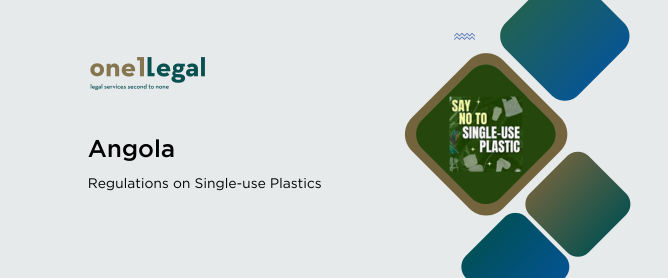29/09/2025
Angola: Regulations on Single-use Plastics

Rui Amendoeira
The Angolan executive has enacted the Regulations on the Production, Importation, Sale and Use of Single-use Plastic Products (SUPs) by way of Presidential Decree 170/25, of 22 September 2025. This initiative is part of the “2025-27 National Action Plan for the Phased Elimination of Single-use Plastic Products”.
Below is a summary of PD 170/25:
- The Regulations are applicable to all Single-use Plastic Products produced, imported, sold and consumed in Angola, as well as the economic agents involved in these activities, except the following:
- SUPs used in the oil and gas, health, cosmetics, personal hygiene, agriculture and construction industries which are subject to specific legislation;
- Biodegradable packaging and poly bags used exclusively for cleaning, hygiene and health;
- Poly bags for containing and transporting bulk or animal products, or for storage of wet food.
- Within 12 months of publication of the Regulations, it is prohibited the production, importation, sale or use of poly plastic bags with a thickness of less than 50 micron, as well as plastic straws, stirrers and plastic-stemmed cotton buds. Within 36 months of publication of the Regulations, this prohibition will extend to EPS and XPS cups, non-recyclable plates and cutlery and less than 500 ml PET bottles;
- The economic agents must offer consumers alternative products to the above which are reusable, biodegradable and compostable. The alternative products are listed in Presidential Decree 122/25, of 29 May 2025, which approved the “2025-27 National Action Plan for the Phased Elimination of Single-use Plastic Products”;
- The producers and importers of biodegradable plastic products must obtain a Biodegradable Certificate from the Ministry of Environment;
- Plastic bags up to 50 microns thick are subject to a fee to be established in specific legislation;
- The local authorities together with the Ministry of Environment are responsible for the collection of SPUs to prevent their dispersion in the environment;
- The Ministry of Environment shall develop strategies and awareness campaigns on the sustainable production and use of plastics, and the use of alternative, environmental friendly products;
- The following fines are applicable in case of breach of the Regulations:
- For individuals – a fine between a minimum of ¼ and a maximum of 50 minimum wages;
- For companies – a fine between a minimum of 10 and a maximum of 300 minimum wages.
These fines will increase by 100% in case of repeated offences.
- In addition to the above fines, the following penalties may also be imposed:
- Loss of the objects that are involved in the offence;
- Full of partial shutdown of the relevant facilities for a maximum period of 2 years;
- Suspension of license or permit for a maximum period of 2 years.

